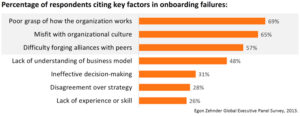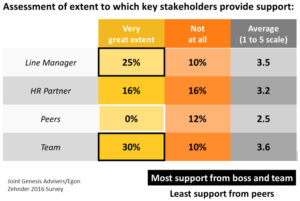
Does your company really do a good job of onboarding new hires?
In “Onboarding Isn’t Enough,” a recent Harvard Business Review article I co-authored with Mark Byford and Lena Triantogiannis from Egon Zehnder, we showed that many companies think they are doing a good job of onboarding newly-hired executives when they actually aren’t.
This is important because new executives who fail or underperform (up to 40% according to some studies) impose very high direct costs (recruiting, and salary) and indirect costs (lost opportunities to turnaround, sustain, and grow businesses) on the companies who hire them.
Why aren’t companies doing a good job in executive onboarding? Because (1) there has been no good definition of what “excellent onboarding” actually involves, (2) the real reasons why newly-hired executives fail or underperform have to do with political and cultural integration challenges for which few company onboarding systems provide support, and (3) this support is best provided by transition acceleration advisors that have specialized skills, not by the leadership development coaches used by many organizations.
Why new hires fail or underperform
In 2013, Egon Zehnder surveyed more than 500 experienced executives, exploring why new hires struggled when onboarding. The results, summarized below, showed that the biggest reasons were about politics and culture, not competence or experience. Executives failed when they didn’t understand “the real rules of the game” and/or failed to build critical relationships, especially with peers.
The importance of peers was validated in a subsequent survey of onboarding executives conducted jointly by Genesis Advisers and Egon Zehnder in 2016. The newly-hired leaders were asked to assess the degree to which they received support from key stakeholders, including their hiring managers, teams, and HR business partners. The results, summarized below, showed that they received the least support from peers. The implication is that while failure to build effective working relationships with peers is one of the biggest reasons for onboarding failure, newly-hired leaders can’t expect their peers to spontaneously provide them with support.
Cultural adaptation and political connection are, of course, very difficult challenges for newly-hired executives to meet on their own. Figuring out how to operate in a new cultural/political system without support is like sailing through dangerous waters in a fog without radar, sonar, or GPS. The implication is that company onboarding systems that don’t explicitly support new hires in integrating, by adapting to the culture and building critical relationships, are setting them up to fail.
What (many) company onboarding systems don’t do
Given that it’s so important to help new hires integrate effectively, it’s surprising that few companies, even large global ones, do a good job. A series of surveys of senior HR executives conducted jointly in 2015/16 by Genesis Advisers and Egon Zehnder, summarized below, showed that most companies did a good job of getting new hires into the company but few helped leaders integrate into the culture and build critical relationships.
Percentage of senior HR leader assessing their organizations as being effective in key dimensions of onboarding and integration:
The direct and opportunity costs of failure or underperformance by outside hires are very high, and studies have shown executive onboarding failure rates of 25 to 40%. This is a surprising finding. One explanation is that senior management (including HR leadership) don’t understand that what they are doing for “onboarding” today isn’t sufficient. Other explanations including “sink-or-swim” cultures that discourage providing support for leaders in transition—I call this leadership development through Darwinian evolution—and a lack of clarity for who is responsible for integrating new leaders. On the latter issue, recruiting and talent acquisition groups are often responsible for getting leaders onboard but not for getting them integrated and fully up to speed.
To assess the effectiveness of onboarding systems, we created an online Organizational Onboarding Effectiveness Assessment which is available free of charge. Use it to see how your company rates relative to the global sample of companies we studied.
Key takeaways
The research provided rich insight into the limitations of many companies’ existing executive onboarding systems. So, start by assessing how well your company is doing today by using the Organizational Onboarding Effectiveness Assessment.
If your company has a weak system for onboarding and integration, evaluate potential ways to strengthen it, looking specifically at the benefits of providing newly-hired executives with transition acceleration advisors—either by training HR business partners/internal consultants or by engaging with external providers.
Michael D. Watkins is Professor of Leadership and Organizational Change at IMD. He directs the First 90 Days, for leaders in transition. He co-directs Transition to Business Leadership (TBL), a program designed for experienced functional managers who either have recently transitioned or will soon transition into a business leadership position.
Research Information & Knowledge Hub for additional information on IMD publications

in I by IMD 19 February 2024
![How to develop future-ready talent – and do it fast [Video]](https://www.imd.org/ibyimd/wp-content/uploads/2024/02/future-talent-720x630.jpg)
in I by IMD 5 February 2024

in I by IMD 5 February 2024

in I by IMD 2 February 2024




in MIT Sloan Management Review Blog 7 December 2023

Research Information & Knowledge Hub for additional information on IMD publications
in I by IMD 19 February 2024
Research Information & Knowledge Hub for additional information on IMD publications
in I by IMD 5 February 2024
Research Information & Knowledge Hub for additional information on IMD publications
in I by IMD 5 February 2024
Research Information & Knowledge Hub for additional information on IMD publications
in I by IMD 2 February 2024
Research Information & Knowledge Hub for additional information on IMD publications
Research Information & Knowledge Hub for additional information on IMD publications
Research Information & Knowledge Hub for additional information on IMD publications
Research Information & Knowledge Hub for additional information on IMD publications
in MIT Sloan Management Review Blog 7 December 2023
Research Information & Knowledge Hub for additional information on IMD publications
Research Information & Knowledge Hub for additional information on IMD publications


